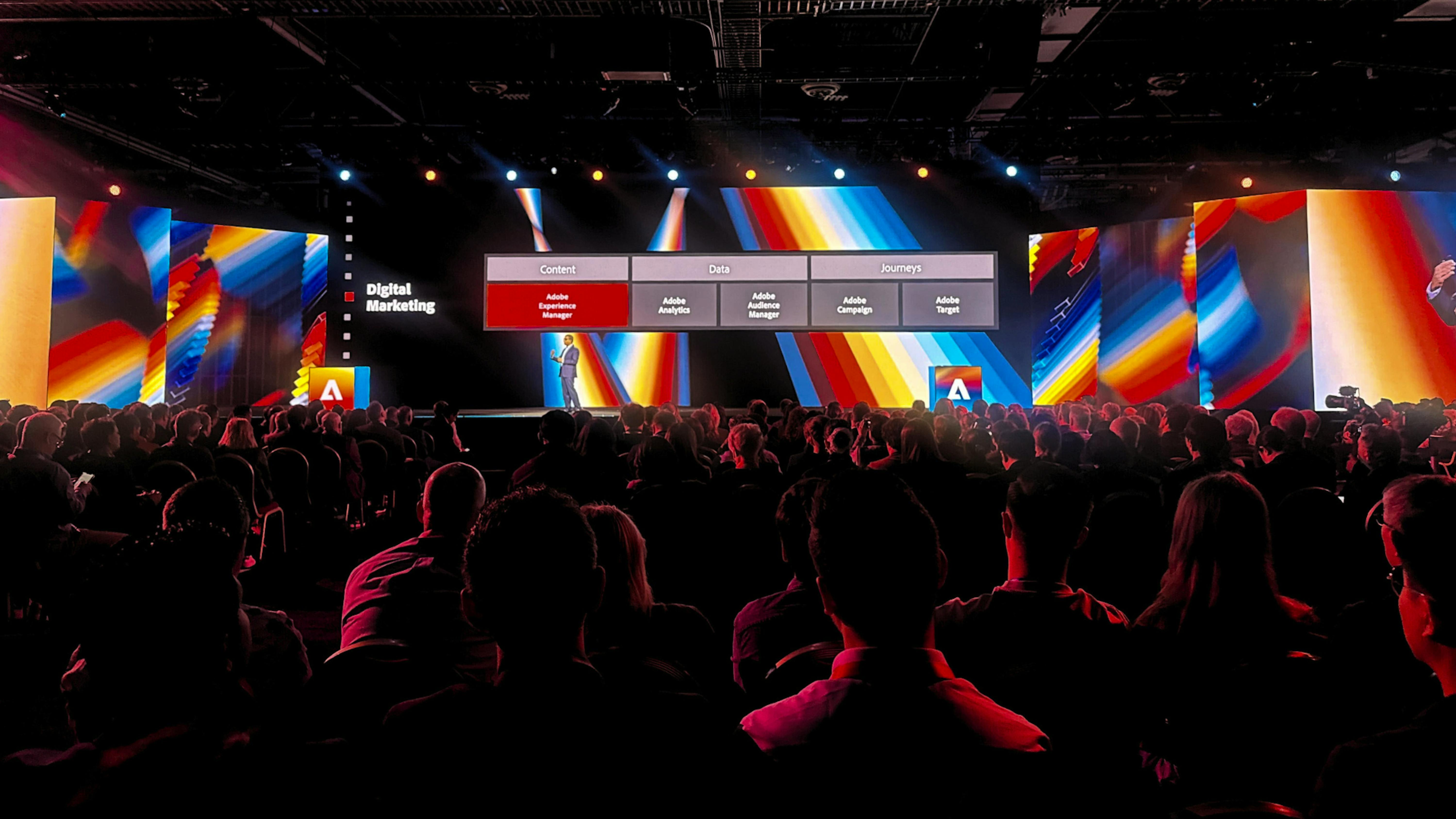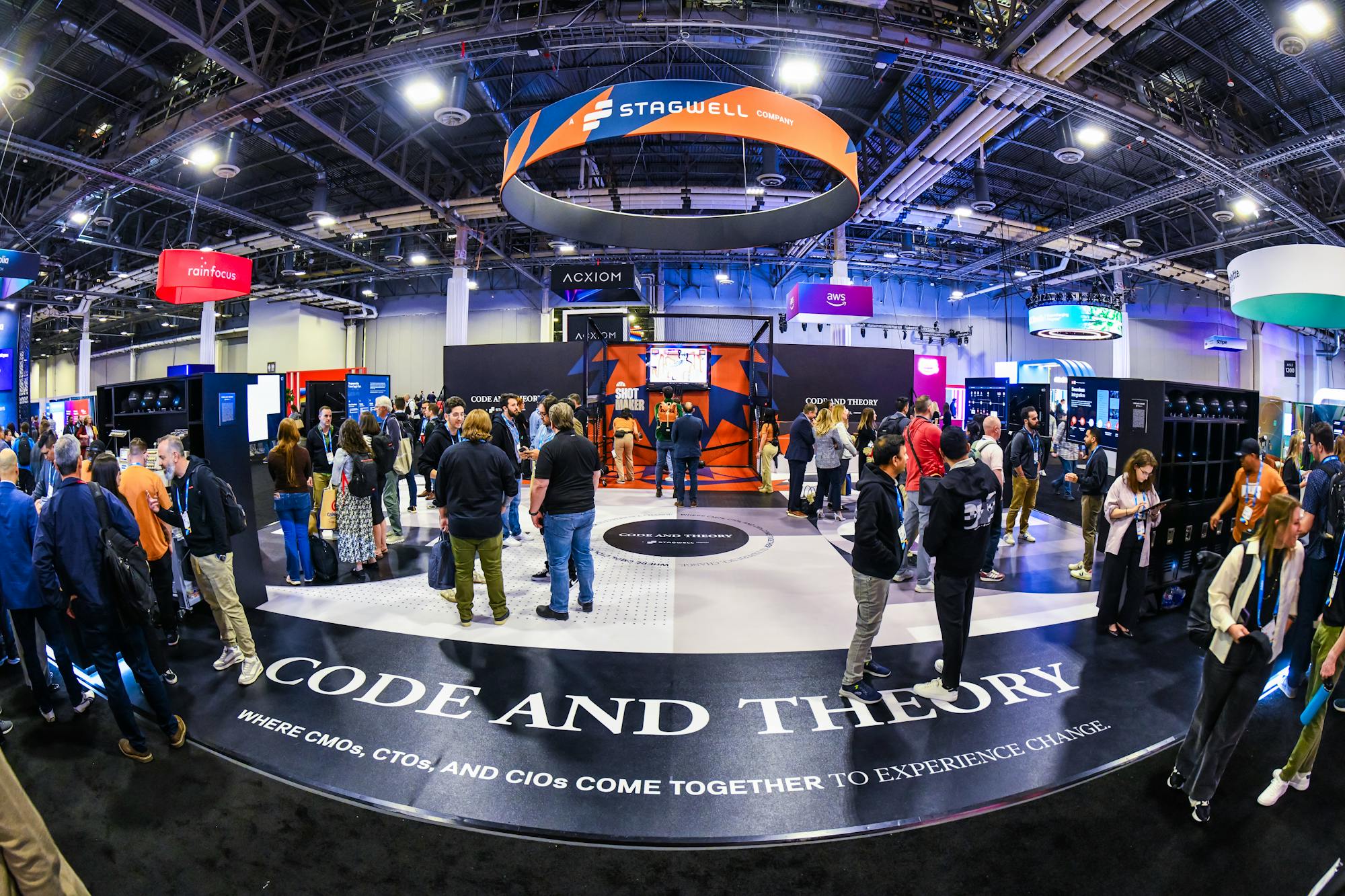
Day One at Adobe Summit Kicks Off the ‘Golden Age of Design’
By the Code and Theory Enterprise Experience Transformation Team
March 19, 2025
This year’s Adobe Summit, the 23rd rendition, got off to a rousing start on Day One with Adobe CEO Shantanu Narayen declaring the current era as the “Golden Age of Design” in his opening remarks. He identified GenAI as the game changer for creativity and production. “AI is accelerating the creative aperture and opening the content floodgates,” says Narayen.
Narayen’s right. Design is having a moment. But what’s really happening is a full-scale evolution in how creativity, technology and marketing collide. GenAI isn’t just expanding the aperture; it’s changing the entire lens. There’s no longer time to wait to start using it.
What stood out most wasn’t just the shiny new tools but rather the palpable shift in mindset. A new kind of creativity is being shaped — faster, sharper and more composable. The human imagination is being amplified, not replaced. And the brands that thrive will be the ones that know how to use these new capabilities to unlock big ideas, not just efficiency.
People don’t want to be spammed with rubbish — Coca-Cola CEO and Chairman James Quincey
Joining Narayen on the main stage in the morning’s keynote session was Coca-Cola CEO and Chairman James Quincey. The beverage chieftain concurred with his Adobe counterpart, acknowledging that GenAI is truly a breakthrough, transformational technology. According to Quincey, Coca-Cola, an early adopter of Adobe’s analytics solutions, jumped into GenAI with similar courage.
The bottom-up GenAI approach should be championed as a catalyst for an explosion of ideas and concepts, Quincey says. He also thinks that AI will be just as important in figuring out which ideas to kill and keeping the team focused on the highest-value opportunities.
Quincey made it clear, however, that this moment requires action. Not analysis paralysis. Coca-Cola’s approach to GenAI is grounded in experimentation and high standards. Not chasing every idea but choosing the ones worth scaling. That kind of clarity is exactly what’s needed now.

55% of Fortune 500 companies will adopt experience agents to deliver end-to-end autonomous experiences — per Adobe
Here are five other takeaways from an action-packed Day One:
1. Don’t Fall Into the ‘Garbage-in-Garbage-out Trap’
The Code and Theory booth generated serious buzz with the launch of its new Enterprise Experience Transformation practice, led by Chief Transformation Officer (and former Adobe exec) Cory Haldeman. The practice showcases value-realization solutions to accelerate GenAI’s transformative impact on the customer experience.
Leveraging content at scale means getting it right from the start. Drawing on over two decades of digital innovation, Code and Theory pioneers solutions that translate AI's possibilities into measurable business outcomes and extraordinary customer experiences.
2. People Must Stay in the Picture
Quincey was quick to point out GenAI's current shortcomings. For example, GenAI-created people are not at the level where consumers will buy in. But overall, things are headed in the right direction with the ability to make videos with music, voice-overs and customization that can be tweaked endlessly. According to Quincey, the tech can only get better, and at some point in the near future, we should expect a tidal wave of creativity at scale. But it’s vital to remember that AI is built to enhance how people create, connect and scale. The most powerful variable in all of this isn’t the tech. It’s the human behind it.
As the tech continues to improve, Quincey warns that the AI can eventually work so well that it ultimately irritates the consumer. When ads get cheaper and GenAI grabs greater control whereby it chases you until you click “buy,” consumers could draw the red line, where they’ll “want to buy those apps that block everything.”
3. The Responsibility of Personalization Is Upheld By Strong Data Strategies
In their session about unlocking personalization at scale, Morgan Stanley’s wealth management group talked about how they use personalization to uphold their position as the undisputed choice in wealth management. For them, it means they need to uphold the same quality of service to every individual who has a relationship with Morgan Stanley, regardless of the type of relationship or account they have. This is a big responsibility, ensuring every conversation is seen as an opportunity to reinforce their leadership.
The Next Best Idea initiative they created in 2022 is a groundbreaking example. Creating propensity scores and overlaying marketing data generate insights about the “next best action” Morgan Stanley should take for an individual customer within every channel they engage with, ensuring the customer gets a highly tailored experience.
To achieve this level of personalization, Morgan Stanley’s message remained consistent with the day’s other presentations: Start with a clear vision and a clear data strategy. Otherwise, you will push irrelevant content. Morgan Stanley’s approach, creating a “category of one,” is powerful, but it only works when it’s matched with emotional intelligence. Automation alone won’t get you there; a sharper story will.
4. Real-Time Collaboration Requires Unified Systems
Adobe Chief Brand Officer Heather Freeland praised its GenStudio solution, which consolidates separate tools into a coherent dashboard and unified user experience. Switching between dashboards is expensive. With everything in the same space, it streamlines operations — a true game-changer.
With hundreds of agency partners around the world, Adobe needed to consolidate its toolset in one place to ensure performance at today’s business speed. Building its own centralized creative environment via GenStudio says everything: The future of marketing lies in systems that are coherent, agile and composable, built for real-time collaboration, not siloed execution.
According to Freeland, creatives no longer design assets but creative platforms and ecosystems in a world where scale is essential. Training people to think differently about how they generate concepts versus singular ideas has become the rally cry.
Among the most important shifts highlighted: Creatives need to be systems designers. It’s no longer about individual assets. It’s about designing creative platforms that are modular, scalable and flexible. The concept-to-scale mindset is the new default, and AI literacy is a new baseline skill, making prompt training essential for creatives. It used to be about the brand design system, and now it’s about the entire campaign ecosystem being designed from inception to scale.
5. Brand Storytelling Has to Balance Timeliness With Timelessness
Storytelling has to scale without losing soul. Coca-Cola’s design leaders reminded us that timeless brand identity still matters. Great storytelling is consistent, not repetitive. Distinct, not generic. And no matter how smart the tools become, it’s people who set the tone.
What’s really changing? Everything. The rate of change has never been faster. Expectations have never been sharper. The only way forward is to build for speed, without losing meaning. That’s the real challenge and the real opportunity. Creativity in the hands of the right people is still the most powerful force in business.
According to Rapha Abreu, The Coca-Cola Company’s VP of Global Design, design is the connective tissue that creates an iconic, distinct and universally recognizable brand identity. Brand guidelines need to be consistent. AI doesn't replace creativity; it enhances it. Humans lead, and AI follows. If AI is making creative decisions, you’ve gone too far.
Shekhar Gowda, The Coca-Cola Company’s VP of Global Marketing Technology, says it’s his mission to make sure the company has the right tools and platforms for automation and machine learning. With two hundred brands in 220 markets, the volume of required content is staggering. “It’s not just volume but about maintaining the brand across every execution and every channel.”